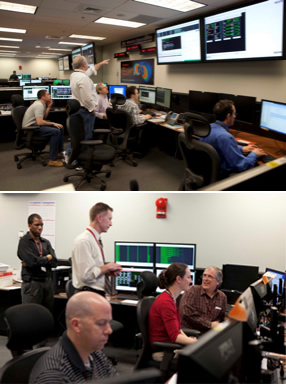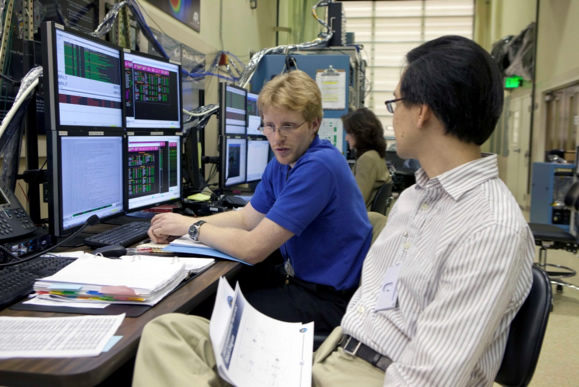March 19, 2012
Media Contact:
Geoff Brown
(240) 228-5618
Geoffrey.Brown@jhuapl.edu
Time Traveling: Simulation Creates ‘10 Days in the Life’ of RBSP, circa 2013
 six weeks of rigorous space environment simulation, another part of the RBSP team is busy ensuring that the spacecraft will successfully perform their science gathering mission after launch in August 2012.
six weeks of rigorous space environment simulation, another part of the RBSP team is busy ensuring that the spacecraft will successfully perform their science gathering mission after launch in August 2012.
On March 13, the RBSP team at the Johns Hopkins University Applied Physics Laboratory (APL) in Laurel, Md., began a 10-day-long mission simulation designed to end March 22, 2012. It is the third such simulation to date, but the first full systems test, and it will put the instruments and RBSP control systems through every phase of operation during the period designated as February 13-23, 2013. “This test puts both spacecraft, as a system, through the paces they will go through during the mission,” says Ray Harvey, RBSP mission operations manager, and lead ground segment system engineer.
“It’s a 24-hour-a-day simulation of both spacecraft in their routine science operations phase, about six months after launch,” Harvey explains. “We’re operating both spacecraft from the newest mission operations center [MOC] here at APL, using the same hardware and software, and same processes and procedures, that we’ll use after the actual launch.” Operating the instruments while they are in thermal vacuum testing is a key verification of the systems’ capabilities (an RBSP team stationed by the thermal vacuum chambers monitors the spacecraft at all times, including during the simulation).
Proving Processes
The mission simulation, run entirely from the MOC, recreates almost every detail of the day-to-day science operation of RBSP so that engineers and scientists can make sure their plans and equipment will function once the spacecraft are in orbit, which will vary from approximately 600 kilometers (about 311 miles) to 30,600 kilometers (about 19,014 miles) above the Earth. “We’re working to validate our concepts for operations,” says Harvey. “We’re sending commands to the spacecraft, then bringing science data down to the ground. This 10-day test will really prove out our process. There are more than 400 requirements we’ll be verifying during the test.”
The science instrument teams – located at the University of New Hampshire, University of Iowa, University of Minnesota, New Jersey Institute of Technology and the National Reconnaissance Office in Virginia – will be sending commands to the MOC at APL. When the simulation calculates the spacecraft are in contact with a satellite station (located across the globe, including APL’s 60-foot dish antenna), the MOC sends those commands to RBSP. The instruments then send simulated data back to the MOC during later contacts, and the APL team makes the data available to the science instrument teams for their continued processing. “We have two people working each spacecraft during every contact,” Harvey says. “We need to get 5.9 gigabytes (GB) of data down from each spacecraft each day” – during an RBSP-to-Earth contact period of about 3.5 hours – “but we’re trying to get 6.3 GB for additional housekeeping data and to account for possible ground station outages.” For comparison, most common DVDs hold about 4.7 GB.
A design concept known as “decoupling” helps both the mission operations team and the science instrument teams do their jobs at the same time without interfering with one another. The science instrument systems are designed to run independently (decoupled) from basic spacecraft systems such as communications and propulsion. The science instrument teams can run all of their simulation tests on their own without worries of conflicting needs for spacecraft resources with the mission simulation team.
Tough Tests
The spacecraft themselves are undergoing significant simulated tests during this 10-day stretch. “We picked this period in 2013 to test, in part, because it’s a difficult period for spacecraft operation,” Harvey says. “They’re at maximum eclipse, meaning they won’t see a lot of sunlight to power the spacecraft; they’ll be lapping one another; and then we’re going to do a precession maneuver to re-orient the spacecraft at the sun to maximize the power gathered by the solar panels. We’re also going to perform a collision avoidance [COLA] maneuver. We’ll be performing that with a team from NASA’s Goddard Space Flight Center; they’re the folks who keep track of our orbit and let us know about any possible encounter with another object up there.”
The team will also perform a test that will verify that the spacecraft’s Hardware Command Loss Timer (HWCLT) works; this device is a safety valve that shuts down critical spacecraft systems if it doesn’t receive a specific command from the RBSP ground team after a certain period of time. Once the spacecraft shuts down the majority of its systems, the RBSP team will then attempt to recover it from the shutdown. “We just finished a 10-day simulation on our RBSP simulator,” Harvey says, “and we learned a lot about the recovery that we’ll be using in this real mission simulation. Models are good, but we really like to test the flight units. That’s where we learn the most.”
Creating and revealing challenges and issues – and overcoming them – is the real goal of these simulations. “We thought we’d do the simulation at the hardest point in the mission to prove out as much as possible,” says Harvey. “We’ll judge our success by how much we learn, and we learn much more from identifying problems and fixing them than if everything runs perfectly smooth. With this 10-day test, if something goes wrong on day two, we want to have it fixed for day three to see if it works.”

While the RBSP 10-day mission simulation is being run from APL's mission operations center (MOC), engineers located near the thermal vacuum testing chambers monitor data and the twin spacecraft themselves, making sure that the testing is proceeding as designed and that RBSP is safe and secure.
RBSP is scheduled for launch no earlier than Aug. 15, 2012, from Cape Canaveral Air Force Station, Fla. APL built the RBSP spacecraft for NASA and manages the mission. The RBSP mission is part of NASA's Living With a Star program, guided by the Heliophysics Division of the NASA Headquarters Science Mission Directorate in Washington.
The Applied Physics Laboratory, a not-for-profit division of The Johns Hopkins University, meets critical national challenges through the innovative application of science and technology. For more information, visit www.jhuapl.edu.


© 2024 The Johns Hopkins University Applied Physics Laboratory LLC. All rights reserved.
Privacy Notice/Legal Disclaimer
11100 Johns Hopkins Road, Laurel, Maryland 20723
240-228-5000 (Washington, DC, area) • 443-778-5000 (Baltimore area)